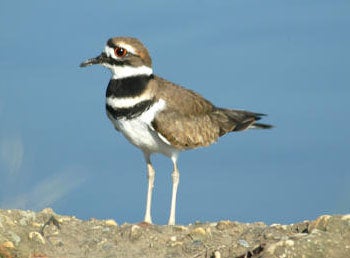SCIENTIFIC NAME:
Charadrius vocifurus
OTHER NAMES:
killdee; pasture-bird; noisy plover; field plover; chattering plover
STATUS: Breeder. Common in all regions and seasons. Low Conservation Concern.
DESCRIPTION:
Killdeer (Charadrius vocifurus) are one of the best known American shorebirds. Sexes are outwardly alike and about the same size. They are 9 to 11 inches long with a wingspan of 19 to 21 inches. They are gray-brown above with white below distinguished by two black bands across the chest. The lower back, rump, and upper tail are an orange color and the legs and feet are flesh colored. They have a rounded tail with a black band close to the end that is tipped with white. Killdeer sport slim black bills and a white stripe along the wings. They are distinguished by their loud cry of kill-dee kill-deer or kill-deeah.
DISTRIBUTION:
Killdeer nest from northwest British Columbia and Quebec, south to California, Mexico, the Gulf Coast of the United States to the Bahamas and Greater Antilles and from Peru and Chile to Alaska. Killdeer winter from south British Columbia, Oregon, and Utah to the Ohio Valley and New York, south to Columbia, Peru, Chile, and Venezuela. They often nest where they winter and males have a greater tendency to return to the same mates and breeding areas than do females. The killdeer is one of the earliest shorebirds to migrate in spring. They may arrive in Canada or the United states as early as February to April.
HABITAT:
Although Charadrius vocifurus are shorebirds, they inhabit pastures, meadows, and dry uplands often many miles from water. They usually fly singly in an erratic manner and are seldom seen in large flocks.
FEEDING HABITS:
illdeer can be observed running across a field or meadow, then coming to a sudden stop and standing still as if to look or listen. Then suddenly they will peck at the ground in quest of insects. The bird will alternately run and stand in this manner continually in its search for food. About 98% of their food comes from insects found in fields, riverbanks, or possibly lawns. They eat mostly weevils, beetles, grasshoppers, ants, caterpillars, bugs, caddis flies, and dragonflies. They may also ingest spiders, ticks, centipedes, earthworms, snails, crayfish, crabs, and some seeds. Killdeer have been known to follow a farmer plowing a field to feed on grubs or beetles found in the fresh furrow. They may feed in shallow water but like many other shorebirds leave the water to defecate on dry land.
LIFE HISTORY AND ECOLOGY:
Killdeer usually nest in slight depressions in the ground anywhere from bare roads to cultivated fields, meadows and pastures. They have also been known to nest on tarred roofs fifty feet above ground. Nests are usually lined with pebbles, grasses, and weed stalks. Eggs are incubated for 24 days by both parents. The eggs in Alabama are usually laid from April to July. They average three to five gray-buff spotted eggs speckled with gray or black. Young usually fly about 25 days after hatching. Killdeer have been known to raise two broods per season, but one is the norm. Parents may protect young by flying into the face of an intruder or luring intruders away with a distraction display mimicking a crippled bird.
REFERENCES:
Terres, John K., 1991. The Audubon Society Encyclopedia of North American Birds. Wings Books. New York. 740-741 pp.
Peterson, Roger Tory. 1980. A Field Guide to the Birds. Houghton Mifflin Co. Boston. 120 pp.
AUTHOR:
Bennett Moseley, Wildlife Biologist, Division of Wildlife and Freshwater Fisheries






